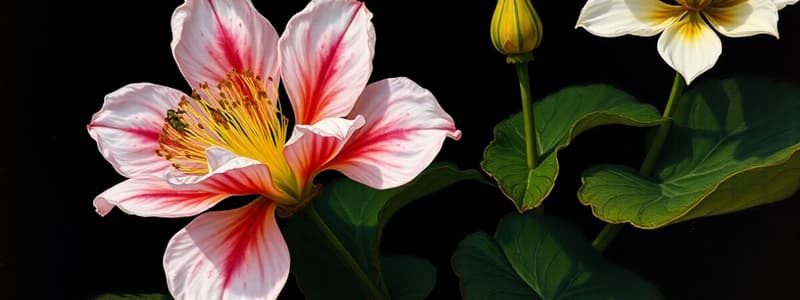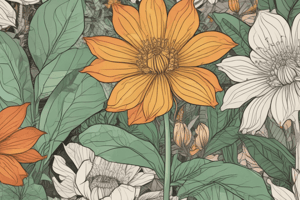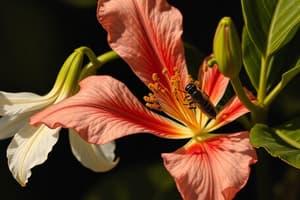Podcast
Questions and Answers
What is the difference between pollination and fertilization?
What is the difference between pollination and fertilization?
- Fertilization is only found in animal reproduction.
- Pollination and fertilization are the same process.
- Pollination occurs after fertilization.
- Pollination is the transfer of pollen to the stigma, while fertilization is the fusion of sperm and egg. (correct)
A perfect flower contains both male and female reproductive structures.
A perfect flower contains both male and female reproductive structures.
True (A)
What structure is responsible for producing pollen in a flower?
What structure is responsible for producing pollen in a flower?
Anther
In flowering plants, the _____ is the swollen part of the stem that bears flowers.
In flowering plants, the _____ is the swollen part of the stem that bears flowers.
Match the following types of flowers with their characteristics:
Match the following types of flowers with their characteristics:
Which of the following is a structure found in a typical dicot flower?
Which of the following is a structure found in a typical dicot flower?
A spike is a type of inflorescence where flowers are directly attached to the main stem without pedicels.
A spike is a type of inflorescence where flowers are directly attached to the main stem without pedicels.
What does the term 'whorl' refer to in botany?
What does the term 'whorl' refer to in botany?
What is the collective term for sepals?
What is the collective term for sepals?
A complete flower contains all four types of floral organs: sepals, petals, stamens, and pistils.
A complete flower contains all four types of floral organs: sepals, petals, stamens, and pistils.
What is the function of the sepals?
What is the function of the sepals?
The male floral organs of a flower are referred to as the ______.
The male floral organs of a flower are referred to as the ______.
Which part of the carpel connects the stigma to the ovary?
Which part of the carpel connects the stigma to the ovary?
Match the floral organ with its definition:
Match the floral organ with its definition:
A flower that has both male and female reproductive organs is considered imperfect.
A flower that has both male and female reproductive organs is considered imperfect.
A flower that is missing one or more whorls of floral organs is termed ______.
A flower that is missing one or more whorls of floral organs is termed ______.
What term is used for plants that have staminate and pistillate flowers on separate plants?
What term is used for plants that have staminate and pistillate flowers on separate plants?
In a polygamous plant, all flowers are perfect.
In a polygamous plant, all flowers are perfect.
What are the two bracts that enclose the sexual parts of a grass floret?
What are the two bracts that enclose the sexual parts of a grass floret?
A spikelet consists of two __________ enclosing one or more florets.
A spikelet consists of two __________ enclosing one or more florets.
Which cereal has many florets per pair of glumes?
Which cereal has many florets per pair of glumes?
Match the following terms with their correct descriptions:
Match the following terms with their correct descriptions:
The ovary in a cereal flower is primarily located outside the lemma and palea.
The ovary in a cereal flower is primarily located outside the lemma and palea.
What happens to the ovule once it is pollinated?
What happens to the ovule once it is pollinated?
What term describes the flowering structures that consist of portions of the stem plus the flowering units?
What term describes the flowering structures that consist of portions of the stem plus the flowering units?
Determinate growth habit allows for continued vegetative growth even after flowering begins.
Determinate growth habit allows for continued vegetative growth even after flowering begins.
What is the process called when pollen is transferred from the anther to the stigma?
What is the process called when pollen is transferred from the anther to the stigma?
The male reproductive organs of a flower are known as the ______.
The male reproductive organs of a flower are known as the ______.
Match the flower part with its function:
Match the flower part with its function:
What is the name of the process when an anther sheds its contents?
What is the name of the process when an anther sheds its contents?
The ovary is part of the male reproductive organ of a flower.
The ovary is part of the male reproductive organ of a flower.
What occurs during fertilization in flowering plants?
What occurs during fertilization in flowering plants?
What is the term for a dry, single-seeded fruit with the testa fused to the pericarp?
What is the term for a dry, single-seeded fruit with the testa fused to the pericarp?
Only 10% of flowering plants rely on wind pollination.
Only 10% of flowering plants rely on wind pollination.
What type of inflorescence has flowers arranged along a central rachis with tiny stems called pedicels?
What type of inflorescence has flowers arranged along a central rachis with tiny stems called pedicels?
In a panicle inflorescence, flowers are attached to branches by small stalks called ______.
In a panicle inflorescence, flowers are attached to branches by small stalks called ______.
Which of the following plants is an example of a spike inflorescence?
Which of the following plants is an example of a spike inflorescence?
A simple umbel has many small umbels clustered together at the top of a peduncle.
A simple umbel has many small umbels clustered together at the top of a peduncle.
Name one flower adaptation for wind pollination.
Name one flower adaptation for wind pollination.
Match the following types of inflorescence with their descriptions:
Match the following types of inflorescence with their descriptions:
What term describes the flower head structure found in the Asteraceae family?
What term describes the flower head structure found in the Asteraceae family?
90% of flowering plants are adapted for self-pollination only.
90% of flowering plants are adapted for self-pollination only.
What is the function of nectaries in dicot flowers?
What is the function of nectaries in dicot flowers?
A __________ is a dry single-seeded fruit with the pericarp fused to the testa.
A __________ is a dry single-seeded fruit with the pericarp fused to the testa.
Match the following fruit structures with their characteristics:
Match the following fruit structures with their characteristics:
Which adaptation is NOT typically found in dicot flowers to attract insects?
Which adaptation is NOT typically found in dicot flowers to attract insects?
The ovule develops into a seed after fertilization.
The ovule develops into a seed after fertilization.
What happens to the ovary after successful fertilization in flowering plants?
What happens to the ovary after successful fertilization in flowering plants?
Flashcards
Pollination vs. Fertilization
Pollination vs. Fertilization
Pollination is the transfer of pollen from the stamen to the pistil. Fertilization is the fusion of the pollen and ovule to create a seed.
Flower Structures (Dicot)
Flower Structures (Dicot)
Sepal, petal, stamen (anther and filament), and pistil (stigma, style, and ovary) arranged in whorls.
Flower Structures (Monocot)
Flower Structures (Monocot)
Different arrangement of structures compared to dicots. Example: cereal flowers.
Spikelet Structure
Spikelet Structure
Signup and view all the flashcards
Perfect vs. Imperfect Flower
Perfect vs. Imperfect Flower
Signup and view all the flashcards
Monoecious Plant
Monoecious Plant
Signup and view all the flashcards
Complete vs. Incomplete Flower
Complete vs. Incomplete Flower
Signup and view all the flashcards
Reproductive Growth Stages
Reproductive Growth Stages
Signup and view all the flashcards
Inflorescence
Inflorescence
Signup and view all the flashcards
Determinate Growth Habit
Determinate Growth Habit
Signup and view all the flashcards
Indeterminate Growth Habit
Indeterminate Growth Habit
Signup and view all the flashcards
Pistil/Carpel
Pistil/Carpel
Signup and view all the flashcards
Stamen
Stamen
Signup and view all the flashcards
Dehiscence
Dehiscence
Signup and view all the flashcards
Pollination
Pollination
Signup and view all the flashcards
Fertilization
Fertilization
Signup and view all the flashcards
Sepal
Sepal
Signup and view all the flashcards
Petal
Petal
Signup and view all the flashcards
Carpel/Pistil
Carpel/Pistil
Signup and view all the flashcards
Complete Flower
Complete Flower
Signup and view all the flashcards
Incomplete Flower
Incomplete Flower
Signup and view all the flashcards
Perfect Flower
Perfect Flower
Signup and view all the flashcards
Imperfect Flower
Imperfect Flower
Signup and view all the flashcards
Caryopsis
Caryopsis
Signup and view all the flashcards
Wind Pollination
Wind Pollination
Signup and view all the flashcards
Spike Inflorescence
Spike Inflorescence
Signup and view all the flashcards
Raceme Inflorescence
Raceme Inflorescence
Signup and view all the flashcards
Panicle Inflorescence
Panicle Inflorescence
Signup and view all the flashcards
Umbel Inflorescence
Umbel Inflorescence
Signup and view all the flashcards
Capitulum Inflorescence
Capitulum Inflorescence
Signup and view all the flashcards
Pedicel
Pedicel
Signup and view all the flashcards
Polygamous plant
Polygamous plant
Signup and view all the flashcards
Spikelet
Spikelet
Signup and view all the flashcards
Glume
Glume
Signup and view all the flashcards
Floret
Floret
Signup and view all the flashcards
Lemma and Palea
Lemma and Palea
Signup and view all the flashcards
Rachilla
Rachilla
Signup and view all the flashcards
Capitulum
Capitulum
Signup and view all the flashcards
Corymb
Corymb
Signup and view all the flashcards
Insect Pollination
Insect Pollination
Signup and view all the flashcards
Nectaries
Nectaries
Signup and view all the flashcards
Fruit Development
Fruit Development
Signup and view all the flashcards
Silique
Silique
Signup and view all the flashcards
Study Notes
Plant Reproductive Growth
- Differentiate between pollination and fertilization.
- List structures of a typical dicot flower.
- List structures of a typical cereal flower.
- List spikelet structures.
- Describe male and female flower structures.
- Describe whorled arrangement in a flower and collective terms for structures.
- Differentiate between monoecious, dioecious, and synoecious plants.
- Differentiate between perfect and imperfect flowers.
- Differentiate between complete and incomplete flowers.
- Describe monocot and dicot fruit structures.
Key Terms and Concepts
- achene: One-seeded fruit.
- androecium: Collective term for stamens.
- anther: Pollen-bearing part of the stamen.
- anthesis: Opening of anthers.
- Asteraceae: Family of plants (e.g., sunflowers).
- Brassicaceae: Family of plants (e.g., mustards).
- calyx: Collective term for sepals.
- capitulum: Flower head.
- carpel/pistil: Female reproductive organ.
- corolla: Collective term for petals.
- complete flower: Flower with all four whorls (sepals, petals, stamens, pistil).
- dehiscence: Opening of plant structure for dispersal.
- dehiscent fruit: Fruit that splits open at maturity.
- dioecious: Plant with separate male and female flowers on different plants.
- flag leaf: Leaf immediately below the stem.
- fertilization: Fusion of sperm and egg cells.
- filament: Stalk of a stamen.
- floret: Small flower in an inflorescence.
- flower: Reproductive structure.
- fruit: Mature ovary containing seeds.
- glume: Bract in cereal spikelets.
- gynoecium: Collective term for carpels/pistils.
- hull: Protective covering around cereal seeds.
- imperfect flower: Flower lacking either stamens or pistils.
- indehiscent fruit: Fruit that does not split open at maturity.
- inflorescence: Group of flowers.
- incomplete flower: Lacking any of the four whorls of floral parts.
- lemma: Bract at the base of a cereal flower.
- legume: Fruit type of pea family.
- monoecious: Plant with both male and female flowers on the same plant.
- nectary: Gland producing nectar.
- ovary: Part of pistil that contains ovules.
- ovule: Structure within the ovary that develops into a seed.
- palea: Second bract in cereal flowers.
- panicle: Branched inflorescence.
- pedicel: Small stalk supporting a flower.
- peduncle: Main stalk supporting an inflorescence.
- perfect flower: Flower with both stamens and pistils.
- petal: Usually colorful part of flower.
- pistil: Female reproductive structure of flowers.
- pistillate flower: Flower with pistils but no stamens.
- pollination: Transfer of pollen to stigma.
- rachis: Main axis of an inflorescence.
- receptacle: Expanded portion of stem where flowers are attached.
- sepal: Leaf-like structure enclosing the flower bud.
- silique: Fruit-type of mustard family.
- spike: Unbranched inflorescence
- spikelet: Small inflorescence unit of grasses.
- stamen: Male reproductive structure of flowers.
- staminate flower: Flower with stamens but no pistils.
- stigma: Part of pistil that receives pollen.
- style: Connects stigma to ovary.
- synoecious: Plant with all perfect flowers.
- whorl: Circular arrangement of floral parts.
General Information on Reproductive Growth
- Shoot apical meristem initiates vegetative parts initially, and then flowering structures.
- Inflorescence is formed by parts of the stem plus flowering units.
- Some plants stop vegetative growth when flowering begins (determinate growth).
- Other plants continue vegetative growth after flowering begins (indeterminate growth).
General Information About Flowers
- Flowers are for sexual reproduction.
- Female parts are pistil/carpel (stigma, style, ovary).
- Male parts are stamens (anther, filament).
- Dehiscence is the opening of structures for dispersal (e.g., anther).
- Pollen release is called anthesis.
- Pericarp is the wall of the fruit, which can dehisce.
- Pollination is transfer of pollen from anther to stigma.
- Fertilization is when sperm cells from pollen fuse with egg cells in the ovule.
Parts of a Flower
- Sepals, petals, stamens, and carpels/pistils are in whorls (concentric rings)..
Flowering of Cereal Crops
- Cereal Inflorescences are composed of spikelets.
- Spikelets have two glumes surrounding florets.
- Within the spikelets, lemmas and paleas enclose florets.
- Ovaries (female) form seeds within lemmas and paleas.
- The main female part is the ovary, which has stigmas for pollen reception.
- Florets have stamens (male parts) that emerge between the lemma and palea.
- Pollination in cereal crops is usually wind-pollinated.
Inflorescence Types
- Spike Inflorescence: Elongate and attached directly to main stem (e.g., wheat, barley, rye).
- Raceme Inflorescence: Flowers attached to central rachis with stalks (e.g., canola).
- Panicle Inflorescence: Branched with small stalks (e.g., oats).
- Umbel Inflorescence: Multiple stalks from a common point (e.g., onions).
- Capitulum Inflorescence: Flower head with many small flowers (e.g., sunflowers).
Dicot Fruit Structures
- Legume: single carpel, splits open at maturity (pea family).
- Silique: Two carpels, long and narrow, splits (mustard family).
- Achene: One-seeded, pericarp separates easily from seed(e.g., Asteraceae).
Dehiscent Fruits
- Pericarp splits open at maturity to release seeds (e.g., legumes, siliques).
Indehiscent Fruits
- Pericarp does not split open (e.g., achenes and caryopses).
Studying That Suits You
Use AI to generate personalized quizzes and flashcards to suit your learning preferences.




